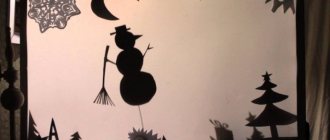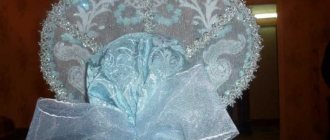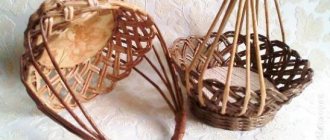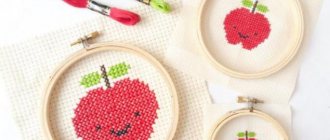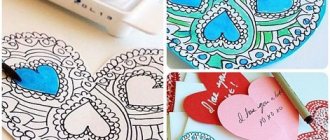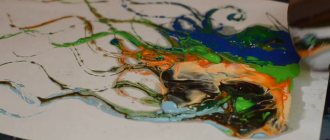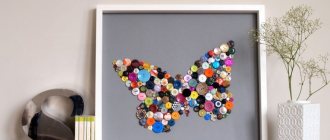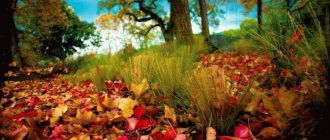Are you suddenly in a bad mood and don't know what to do to distract yourself a little? We suggest rectifying the situation and starting creating beautiful flowers. A flowerbed made of paper will instantly lift your mood.
This activity is not at all difficult; during the process, it will bring you a lot of positive emotions. You can use the result of your work to decorate your apartment. Such a flower bed will always remind you of warm summer days. To create flowers we will need:
- paper of different colors and quality;
- materials for fixation (glue, tape);
- wire;
- scissors;
- large skewers;
- a simple pencil;
- clothespins, paper clips (stationery).
The need for fencing
Luxurious flowers without a frame, like a diamond without a frame, have an unfinished look. The fence transforms the appearance of plantings, giving them neatness and presentability. The edge prevents the spreading of ground cover plants, and it also serves as protection for fragile shoots, keeping pets out of them.
On the dacha site you will certainly find wooden and metal scraps, pipes, brick pieces that will cope with the role of flower bed fences. Remains of slate, tiles or linoleum are suitable for these purposes.
Limestone
A rock with a loose porous structure is good because it is easy to process - it can be split or even cut with a grinder. It can be light in different shades - from ivory and pearl gray to yellowish and pink.
Plastic bottles
The easiest option is to fence a flower garden using plastic containers. At the same time, a double problem is solved: the problem of disposal and the design of the flower bed. This method also saves the plantings from moles by blocking their path.
Bottles can be painted in any tone, achieving colorfulness. They are used to make various figures, for example, two graceful swans swimming in a “flowery” lake are unusually beautiful.
The only thing is that before burying containers with their necks in the ground, you should pour soil or pebbles into them for stability.
Tires are banned?!
Waste tires belong to hazard class III-IV. They emit a number of harmful substances, including carcinogens, heavy metals, toxic odor; are highly flammable.
Their decomposition period is 130 years. Waste of this class cannot be stored and disposed of independently. This should be done by the relevant organizations with collection points.
What the law says
Since July of this year, a lot of articles have appeared on the Internet about the introduction of a ban on growing flowers in car tires and making sculptures from them. Not a single author provides specific references to the new wording of the changes made to the legislative framework.
Federal Law No. 141-FZ dated June 17, 2019 amended the Code of the Russian Federation on Administrative Offences.
Article 8.2 of the Code of Administrative Offenses of the Russian Federation since 2022 includes tougher penalties
In particular, paragraph 1 of Article 8.2 of the Code of Administrative Offenses of the Russian Federation now provides for the imposition of fines for non-compliance with requirements in the field of environmental protection when collecting, accumulating, transporting, processing, recycling or neutralizing production and consumption waste. The size of the fine depends on the category of violators:
- citizens – 1-2 thousand rubles;
- officials - 10-30 thousand rubles;
- persons carrying out entrepreneurial activities without forming a legal entity - 30-50 thousand rubles;
- legal entities – 100-250 thousand rubles.
It turns out that they can be fined not for violating the rules of landscaping, but for storing and burying (disposing) tires on a land plot. It turns out that if rubber swan flower beds are located near an apartment building, the management company will be held accountable, and if on a summer cottage, the owner?!
The authorities of several Russian cities (Sochi, Rostov-on-Don, Irkutsk) had previously banned the use of tires in landscaping, enshrining this in law.
A matter of taste
One can argue endlessly about how beautiful flower beds made from tires and figures made from them are. But since the courtyards of apartment buildings are still replete with elements of such housing office art, it means there are many adherents.
In most cases, tires look like an element of kitsch with a catchy shape and primitive content
In my opinion, this is tasteless, especially when in a limited area there are a large number of bright wheels, the notorious swans, hippos, cartoon characters, pigs from plastic bottles, mushrooms from old enamel bowls, plastic buckets, basins dug into the ground... The feeling, that you are walking past a landfill. Although the same tires, decorated with bright annuals, look quite appropriate and symbolic on the territory of a car park, car company, or driving school.
I honestly admit that for 7 years I myself planted flowers in two large, apparently tractor tires, located on the lawn between the two entrances of an apartment building. I didn’t dare to liquidate them: they stood before me. And I understood why. The soil under the lawn is poor; to set up a good flower garden, you would need to bring a carload of fertile soil and stones, and this requires serious money and a lot of physical labor. And the effort spent on beauty would be a pity due to the unfortunately low culture among the population: all the asters planted in the first year were picked for a bouquet before September 1...
To give a more aesthetic appearance, tires are painted, cut into shapes, reshaped, and supplemented with original parts.
At first, I didn’t paint the balloons at all, until I saw from the balcony how a neighbor with a brush encroached on them: “I renewed my flowerbeds, the paint was still there, so it’s up to you!” I had to paint over the provocative bright yellow color (I managed to smear it on), purchasing a matte, lighter, eye-pleasing shade. I did not cover it completely, but only the inner edging and some protruding parts of the tires. I planted marigolds in them (medium-growing varieties in the center, low-growing varieties along the edge), cineraria, and lobelia. In principle, two such flower beds, decorated in a simple and identical style, looked good on a regularly mowed lawn.
Give free rein to your imagination
You don’t need to have professional design skills or spend money to improve your plot of land, just use your imagination. How do you like an overturned bowl from which a flower river flows?
An old barrel, painted to look like a matryoshka doll or any other funny character, looks very cute and unusual. A hedge made from clay pots will turn an inconspicuous fence into a work of art.
Great idea to use a log, remove the inside and plant flowers in the hole. You can turn the stump left after cutting it into an exquisite flower garden by treating it with the same method or simply placing a pot with cascading plants on it.
The toilet, bathtub, and sink also become the basis for floral oases, just like an outdated umbrella or broken cart, “populated” with flowers.
Beauty aster
From paper of any color (whatever you like) cut out 5 circles (2 large, two slightly smaller and one small). Then fold the circles in half 3 times each. Then we trim the edges (see photo). Next, we unfold each circle and press the edges with our fingers, giving the flower a pointed petal shape. This way the flower will become voluminous. Then we stack all the flowers on top of each other and decorate with a center made of yellow paper. If you want to make the flower bigger, then use more cut out circles.
Let's use tires
Tires that have served their purpose are undoubtedly in every garage. This is the laziest variation on how to make a flowerbed without much effort. They are laid on a flat place or mounted on legs, covered with soil, then plant what you want. Rubber can be painted in any color and installed in several rows, creating a full-scale flowering town.
Note!
- How to make a hot smoked smokehouse - 75 photos of the best ideas and step-by-step instructions
Molds for paving slabs - easy instructions on how to make them yourself (80 photo ideas)
Feeder for chickens - ideas, description of construction and features of creating feeders from scrap materials
Craftsmen manage to reproduce realistic images of animals and birds after cutting and turning clothes for wheels. Rubber samples hung vertically look stylish and advantageous.
How to decorate a flowerbed so that it looks original and unique?
Let's use a little creativity. You can build a fence around the ridge we created. To do this, we will drive stakes of the same height on four sides of our perimeter. If the flowerbed is long, then we drive in a few more support stakes. We weave dry branches between them. You can decorate the top with clay pots, artificial sunflowers, etc.
Note!
Perennial flower beds: TOP-200 photos of the best options and new designs. Instructions and diagram for decorating a flowerbed with your own hands
How to prune tomatoes so that they bear fruit - step-by-step instructions for correct pruning of tomatoes for a better harvest
- Currants have pale leaves, what to feed them - a review of the most effective techniques from a gardener
Viola, popularly called "Pansy", comes from the violet family. It has been popular since the times when ancient tribes in Europe decorated themselves and their homes with these bright flowers.
Viola is winter-hardy, shade-tolerant, but does not suffer much from drought. Seedlings are grown from the end of February. Planting in the ground in a permanent place is carried out depending on the climate, in April or May. Having previously prepared the holes at a distance of ten centimeters from each other, plant them, trample the soil and water them.
We chose a sunny, slightly elevated area for our flowerbed near the house, which means it should be good for “Pansies”.
Kochia is an annual plant that loves sunny places. These are fluffy openwork bushes of emerald color in the summer, and by autumn the outfit becomes purple. They will beautifully highlight our delicate violets.
Stones are used
Stone borders are durable and do not require regular maintenance. They are made of sandstone, limestone, granite. Often they use available pebbles or ordinary cobblestones.
It is enough to cover the borders of the flower garden, and it will be completely transformed. The multi-tiered slate composition in the shape of a spiral has a chic look. The specimens are held together with cement for strength.
Distributing the soil
Now you can fill the future flower garden with soil. Cover the plants and the space between them with soil until the roots are completely covered. You can use any soil: compost, top fertile soil or mixed soil, which can be purchased at the store, is suitable. The main thing is not to use peat in its pure form - it causes the plants to dry out.
Wooden structures
Wood fits harmoniously into the natural atmosphere, so homemade objects are often framed with it. True, wood needs to be treated with special compounds for long-term use. The fence looks like a low picket fence, a picket fence, logs, branches and vines.
Wicker fences are very popular, they perfectly complement any vegetation. Extraordinary borders are made from fancy driftwood. If you install a flashlight in a tub, you can admire the created beauty at night.
Where to place
A stone flowerbed can be placed almost anywhere - at the entrance, in the recreation area, near the gazebo. They can be used to zone space, make borders, fences. Single stone structures look good. They attract attention and become the compositional dominant of the space.
For the well-being of plants, you should not place a stone flower garden under the scorching sun and in an open, well-ventilated area. With the help of flower beds made of stones, you can visually correct the relief and create a fence for other more demanding plants.
In any case, you need to plan the placement in advance, taking into account all the nuances, since dismantling the structure will be difficult. It should not create barriers or hindrances to the movement of people and vehicles, or create obstacles to gardening work. Also take care to protect children from injury.
Location
More often, flowering corners are arranged near the house or gazebo, but shade-loving varieties are planted in the garden between trees, providing access to them with landscaped paths.
Do-it-yourself flower beds and flower beds play the role of framing paths or individual zones and can be round, oval, square, or rectangular in configuration.
A mixborder laid out with a certain pattern is in demand. Flower beds can form islands, have a stepped structure or vertical planting that saves space. The maximum height of flowers in the center gently decreases towards the edges.
The place for climbing specimens is near the fence, the walls of the gazebo and next to small architectural buildings. Representatives of the flora should have enough light, the distance between them should be maintained taking into account further growth.
Types of flower beds of regular composition
Before you start work, you need to decide what type of flower beds we want to create with our own hands at the dacha:
- Ordinary amateur gardeners in open areas arrange simple flowerbeds with a horizontal layout flush with the surface or slightly raised in the center so that the water drains better. They are planted with flowers of the same type, or different varieties. Or plants of 2-3 types;
- along the walls of the house or paths, ridges are arranged - narrow, long stripes with low-growing plants along the edges and tall plants in the center;
- lawns or other plantings can be bordered with borders of ornamental plants (cineraria, sedum) or low-growing ones of the same species (alissum, lobelia);
- plantings of large flowers or ornamental shrubs (dahlia, amaranth, peony) are called tapeworms;
- from the already mentioned elements you can create parterres - compositional combinations of lawns, ridges, borders, alpine slides, etc.;
- on rocky areas that are difficult to adapt to anything else, rock gardens (rockeries) and alpine slides are laid out;
- mixborders are an elegant society of colorfully combined flowers, picking up the baton from each other for continuous flowering.
Combinations by varietal characteristics
Select varieties that require the same lighting, moisture and soil characteristics. Sunny points are loved by roses, peonies, vines, they will be unobtrusively complemented by small lacy gypsophila and decorative lavender. The rose garden is surrounded by marigolds or salvia, which drive away pests.
Areas bathed in sunshine love tulips, hyacinths, and daffodils. The flowering period must also be taken into account so that the planting is always in a blooming state.
Making crafts from A4 sheet
Not so often, but you still have to make such products from ordinary large sheets. Of course, you can use such luxurious crafts anywhere; they look especially good if you decorate walls or a hall with them, that is, use them in the interior of premises.
Each leaf is a large petal that you will have to paint in the desired color.
Larger flower options can also be made in the form of a rose. Initially, you will need to use a template.
And then follow all the steps presented step by step.
Color combination
An important point is to correctly combine plants by color. Fabulous multi-colored bouquets will delight the eye and lift the mood of the owners, giving the site an indescribable charm. A good alliance of red, blue, yellow shades.
The universal white tone suits all eye-catching colors without exception. The brightness of the tall flowers in the middle of the structure is edged by the delicate colors of their low “brothers”.
Chaotically growing vegetation is much inferior in aesthetic terms to an organized planting with a spectacular fence. Photos of decorating flower beds with your own hands are a clear confirmation of this.
When creating colorful ensembles, remember about drainage and timely watering so that your plant world does not lose its visual appeal and riot of colors.
Fashion trends and non-standard solutions
Modern landscape design offers a wide variety of compositions for flower beds in a suburban area. The main direction is “harmony in simplicity.” There are several ways to implement it.
| Type of design | Solution |
| Monochrome (use of a single color scheme) | Greens in different shades: silver-green, blue-green, dark green, lemon green |
| Green-white: tree hydrangea, derain, astilbe, white peonies, white-flowered primrose, jasmine, spotted-leaved hosta, spirea vangutta, mock orange | |
| Green-pink: peonies, roses, clematis, astilbe, heuchera, chrysanthemums, bergenia | |
| Red: red-leaved maples, ornamental barberries, heucheras | |
| Monoformity (selection of planted plants of a single shape) | A combination of plants with a round crown in one flower bed: spherical willow, spherical thuja, round spirea, large-leaved hydrangea bushes, roses on a trunk, rounded forms of herbaceous plants (gray fescue) |
| Contrast (choosing plants with flowers of rich colors) | Blue-yellow (delphinium, irises, violas, suitable varieties of marigolds, nasturtiums, yellow daylilies) |
| Blue-pink (roses and framed with lavender, verbena, matthiola bicorne) |
Another interesting technique is to create vertical flower beds. Strengthening flower containers on the walls of buildings and planting bright annuals in them will decorate boring corners of the garden, and creating columns with petunias placed throughout the height will add originality and rich aroma, turning a flat area into a luxurious voluminous flower garden. Clematis planted near an old tree (species can be used as it is more resistant to unfavorable conditions) will cover the trunk with a wave of flowers, delighting the summer resident with continuous flowering for 3 months.
DIY photo of flower beds
Mini-flower beds in containers made from scrap materials
Creating miniature flower beds in containers is an elegant solution to two problems at once: decorating a summer cottage and getting rid of old unnecessary things. In addition, this arrangement of flowers will help protect them from children and pets. To create a mini-flower bed, you can use anything: from old plumbing to unnecessary clothes and shoes.
Flowers growing in wooden boxes are a mobile and attractive option for a flower bed.
Flowers planted in old shoes look very original. At the same time, the larger the shoe size, the more interesting it can be decorated. Making a flower pot from worn-out shoes is simple: you need to make several holes in the sole, which will help create a drainage system. After this, the inside of the shoe is filled with earth and flowers are planted inside.
Mini-flower beds arranged in shoes look interesting and unusual.
A clear advantage of such an improvised container is the ability to easily move it to a convenient place. You can always place it on your porch, fence or steps. This will allow you to easily decorate the interior at the right time.
An old birdcage can be a good base for creating a flower bed.
Among the disadvantages, it is worth noting the need for daily watering and weekly feeding.
Old toy cars of sufficient size, leather bags and briefcases, a cracked jug, etc. can also be an excellent basis for mini-flower beds.
Ornamental mixborder
This planting method is used to decorate the walls of residential and commercial buildings. In this case, it makes sense to opt for an ethnic or geometric pattern. By recreating it under the wall of the house, it will be possible to organize a harmonious ensemble of architectural forms and garden decorations.
An important advantage of a mixborder is the ability to give a pleasant look to even the most inconspicuous building.
To enhance the visual effect, the gardener can safely experiment with the selection of flower varieties, auxiliary bushes, sculptures and dominants. Watering such a flowerbed occurs almost instantly, and the moisture evaporated by the wall, accumulated overnight, prevents the flowers from drying out from the heat.
Planting density
The most beautiful is considered to be a flower bed with a dense planting. But, in any case, there should be free space for normal growth and development.
- Tall plants are planted at a density of 1-3 plants per 1 square meter. m.
- Medium-sized - 5-7 plants per 1 sq. m.
- Low-growing plants - 7-11 specimens per 1 sq. m.
You can plant carpet plants or ornamental grass between the flowers. This will save you from frequent weeding later.
Selection of location
The location for the flower bed should be chosen taking into account many factors:
- Firstly, lighting . Not all plants love sunlight equally.
- Secondly, the place should be cozy, well protected from drafts and wind.
- Thirdly, the open area is the most convenient. It is possible to approach from all sides, which makes maintenance very easy.
- The place for the flower bed must be level . All irregularities are allowed only as an element of the conceived idea.
When preparing a place for a flower bed, you need to dig up the ground, remove all weeds, and fertilize the soil. If desired, you can put up a small fence or border.
Wire frames
Excellent original compositions can be created using wire mesh frames. They are tightly wrapped with cloth or film, after which they are filled with fertile substrate.
High-rise flower beds look especially advantageous next to:
- Garden verandas;
- Barbecue pavilions;
- Chinese tea houses;
- Anti-solar canopies.

